Although originally I started out thinking about this project in terms of breads, some sort of vaguely formed idea in my head that every culture has some sort of stuffed bread similar to an empanada, samosa, turnover, pasty, etc. – that’s turning out to not be as true as I surmised. So the bread part of this may stray into slightly more pastry-ish, stuffed sorts of things, or perhaps even not stuffed. Soups, however, in one form or another, are ubiquitous in the world. I think. And besides, we love our soup.
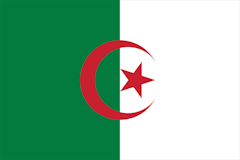 So this week, we’re on to Algeria. The bread, Brik, sometimes called brick. It’s both the name of the final dish, and also the name of the bread, or pastry, or wrapper, I’m not sure what to call it, which is also known as warka. It’s similar in some ways to a phyllo dough, except it’s made from a batter, rather than a rolled out thin sheet. There’s a youtube video here that covers how to make it at home. It’s a little hard to watch, as the helium-voiced narrator describes the “action” (I’m not being rude, she’s really sucking on helium while she cooks). And the soup, one version of what seemed to be the clearly national, or at least ubiquitous soup, Chorba (a.k.a. Shorba, Cheurba), usually followed by a modifier that indicates what’s in it – lamb, chicken, pasta, wheat… I went with Chorba Frik… more below.
So this week, we’re on to Algeria. The bread, Brik, sometimes called brick. It’s both the name of the final dish, and also the name of the bread, or pastry, or wrapper, I’m not sure what to call it, which is also known as warka. It’s similar in some ways to a phyllo dough, except it’s made from a batter, rather than a rolled out thin sheet. There’s a youtube video here that covers how to make it at home. It’s a little hard to watch, as the helium-voiced narrator describes the “action” (I’m not being rude, she’s really sucking on helium while she cooks). And the soup, one version of what seemed to be the clearly national, or at least ubiquitous soup, Chorba (a.k.a. Shorba, Cheurba), usually followed by a modifier that indicates what’s in it – lamb, chicken, pasta, wheat… I went with Chorba Frik… more below.
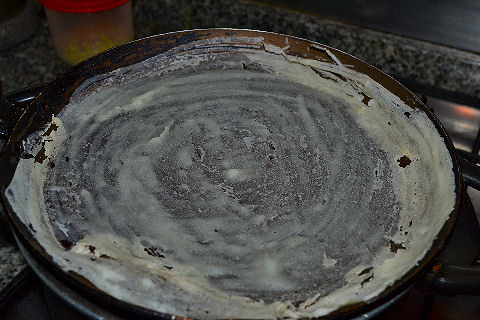 I didn’t find it as easy as she makes it looks, though some of that is likely just practice, and getting the consistency of the batter just right (200 gm flour, 2T fine semolina, 1t olive oil, 1t lemon juice, ½t salt, 100+ml water). I also don’t have a mirror surface non-stick griddle to set atop the steaming pot of water, the closest I could come up with was an old, beat-up crepe pan. Which also meant they were far smaller than hers.
I didn’t find it as easy as she makes it looks, though some of that is likely just practice, and getting the consistency of the batter just right (200 gm flour, 2T fine semolina, 1t olive oil, 1t lemon juice, ½t salt, 100+ml water). I also don’t have a mirror surface non-stick griddle to set atop the steaming pot of water, the closest I could come up with was an old, beat-up crepe pan. Which also meant they were far smaller than hers.
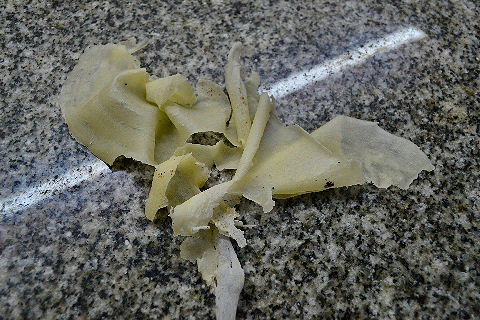 At least half of the warka sheets ended up looking like this – they simply tore or fell apart trying to remove them from the pan. I’d made half a batch of the batter, which should have ended me up with a dozen warka…
At least half of the warka sheets ended up looking like this – they simply tore or fell apart trying to remove them from the pan. I’d made half a batch of the batter, which should have ended me up with a dozen warka…
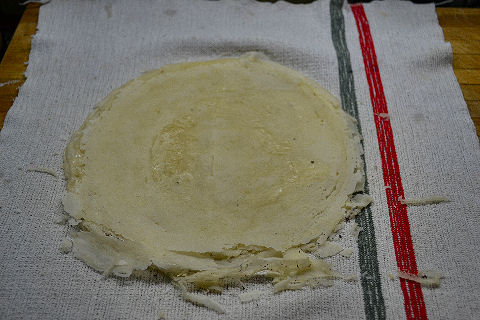 I ended up with six. And four of them stuck together, despite being oiled as she recommended, so in the end, I had two usable ones.
I ended up with six. And four of them stuck together, despite being oiled as she recommended, so in the end, I had two usable ones.
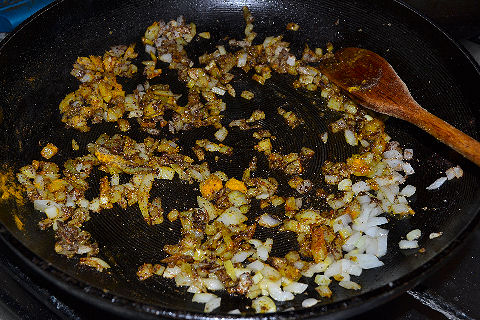 There were several different recommended fillings for the finished briks, but mostly they sounded pretty ordinary – ground beef with some seasoning, cheese and some sautéed greens, but easily the most common, and the most intriguing, was made from tuna. I sautéed a chopped onion, some chopped lemon peel – most of the recipes called for preserved lemon peel, which I didn’t have, so I added in a half teaspoon each of cinnamon, coriander, white pepper and turmeric, spices I commonly use when I’m preserving lemons.
There were several different recommended fillings for the finished briks, but mostly they sounded pretty ordinary – ground beef with some seasoning, cheese and some sautéed greens, but easily the most common, and the most intriguing, was made from tuna. I sautéed a chopped onion, some chopped lemon peel – most of the recipes called for preserved lemon peel, which I didn’t have, so I added in a half teaspoon each of cinnamon, coriander, white pepper and turmeric, spices I commonly use when I’m preserving lemons.
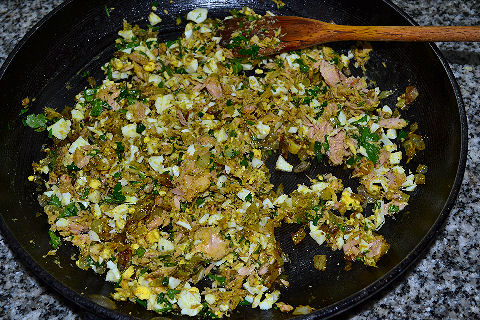 Then added in a drained can of tuna, a couple of chopped hard boiled eggs, a teaspoon of chopped capers, a bunch of chopped parsley, and salt to taste. Let it cool.
Then added in a drained can of tuna, a couple of chopped hard boiled eggs, a teaspoon of chopped capers, a bunch of chopped parsley, and salt to taste. Let it cool.
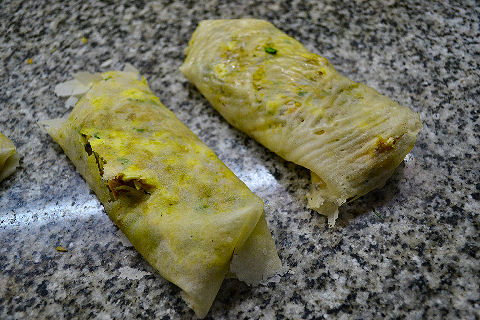 And, wrapped up a couple of blintz style briks with the filling. Even here, the two decent ones I ended up with started to fall apart. There’s clearly something more to the making of this than I got from the video, or, again, it just takes practice. Recommendations abound on the internet for substitutes, the most common seem to be Chinese spring roll wrappers, and were I to make these again, which it’s likely I would, as they’re delicious, that’s what I’d use. Finished off the briks by frying them in vegetable oil until lightly browned on both sides.
And, wrapped up a couple of blintz style briks with the filling. Even here, the two decent ones I ended up with started to fall apart. There’s clearly something more to the making of this than I got from the video, or, again, it just takes practice. Recommendations abound on the internet for substitutes, the most common seem to be Chinese spring roll wrappers, and were I to make these again, which it’s likely I would, as they’re delicious, that’s what I’d use. Finished off the briks by frying them in vegetable oil until lightly browned on both sides.
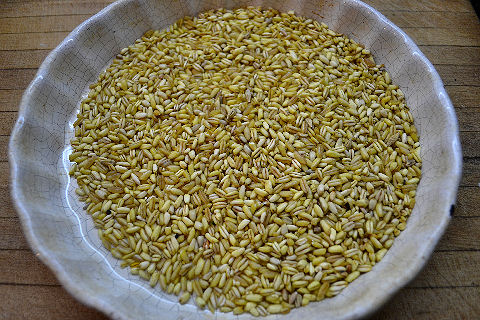 On to the soup. While there are, as I mentioned above, various versions of Chorba, I went with the Chorba Frik, because it was something different. Frik is green wheat that’s been roasted or smoked. Now, green wheat isn’t something I can find here, nor pre-roasted frik. My choices are basically whole wheatberries, peeled wheatberries, or trigo mote, which is a common Peruvian ingredient – peeled wheatberries that have been treated the way you’d treat corn for making tortilla masa harina, with lye. Now, in other parts of the world that’s not as common to find, and the substitution recommendations, surprisingly, weren’t for wheatberries of any sort, but for bulghur wheat, which I do have, and considered, but I liked the idea of a roasted whole wheat of some sort.
On to the soup. While there are, as I mentioned above, various versions of Chorba, I went with the Chorba Frik, because it was something different. Frik is green wheat that’s been roasted or smoked. Now, green wheat isn’t something I can find here, nor pre-roasted frik. My choices are basically whole wheatberries, peeled wheatberries, or trigo mote, which is a common Peruvian ingredient – peeled wheatberries that have been treated the way you’d treat corn for making tortilla masa harina, with lye. Now, in other parts of the world that’s not as common to find, and the substitution recommendations, surprisingly, weren’t for wheatberries of any sort, but for bulghur wheat, which I do have, and considered, but I liked the idea of a roasted whole wheat of some sort.
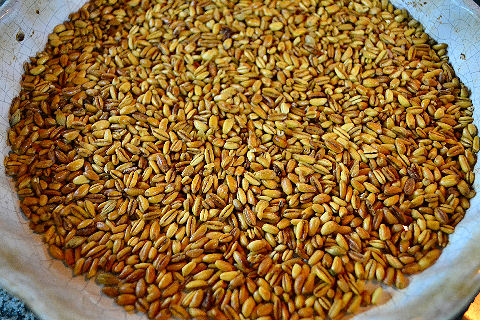 So I roasted trigo mote, the treated wheatberries, figuring those were as close as I was going to get to frik (and the two are used interchangeably, when there’s no other option, in Peruvian cooking, where green wheat, albeit not roasted, is used in northern Peruvian cooking). It gives it a lovely, toasted, smoky flavor.
So I roasted trigo mote, the treated wheatberries, figuring those were as close as I was going to get to frik (and the two are used interchangeably, when there’s no other option, in Peruvian cooking, where green wheat, albeit not roasted, is used in northern Peruvian cooking). It gives it a lovely, toasted, smoky flavor.
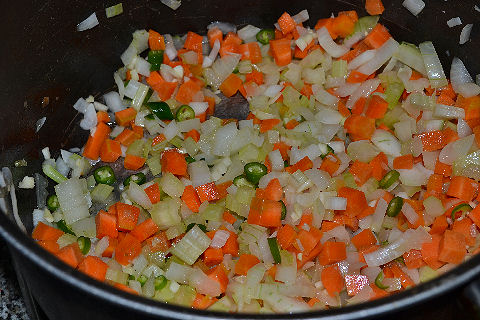 Into a pot with a chopped onion, three cloves of garlic, a couple of green chilies, a couple of stalks of celery, and a large carrot, cooked until starting to soften. Interestingly, several sites online recommend not chopping the celery, but just leaving it in large pieces because they remove it from the soup before serving – apparently considering it a flavoring aromatic, but not an edible vegetable.
Into a pot with a chopped onion, three cloves of garlic, a couple of green chilies, a couple of stalks of celery, and a large carrot, cooked until starting to soften. Interestingly, several sites online recommend not chopping the celery, but just leaving it in large pieces because they remove it from the soup before serving – apparently considering it a flavoring aromatic, but not an edible vegetable.
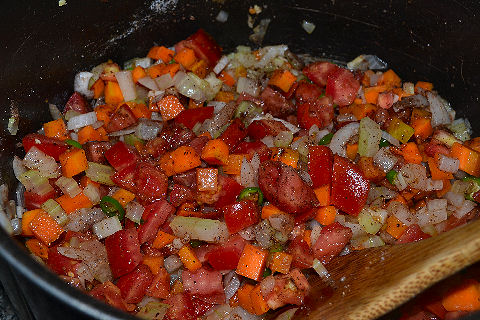 Added a large, chopped tomato and a teaspoon each of coriander, cinnamon and salt. Cooked for a couple more minutes.
Added a large, chopped tomato and a teaspoon each of coriander, cinnamon and salt. Cooked for a couple more minutes.
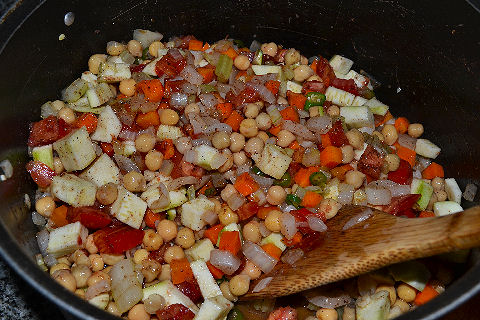 Added in a diced zucchini and a can of chickpeas. Another couple of minutes.
Added in a diced zucchini and a can of chickpeas. Another couple of minutes.
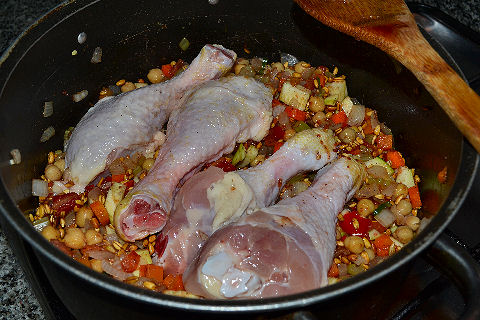 A quartet of chicken thighs nestled in.
A quartet of chicken thighs nestled in.
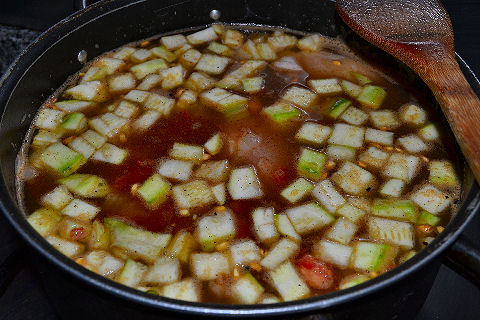 Topped off with water to cover – in this case, no need for a stock – everything that you’d put into making a good chicken stock is already in the pot. Brought to a simmer and cooked until the chicken and the wheat were done.
Topped off with water to cover – in this case, no need for a stock – everything that you’d put into making a good chicken stock is already in the pot. Brought to a simmer and cooked until the chicken and the wheat were done.
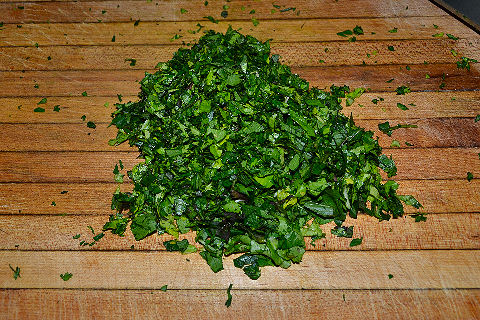 About a cup of mixed herbs – the leaves from the celery stalks, parsley, cilantro, and mint – roughly equal proportions. Stirred in during the last five minutes of cooking.
About a cup of mixed herbs – the leaves from the celery stalks, parsley, cilantro, and mint – roughly equal proportions. Stirred in during the last five minutes of cooking.
Next week, Angola. And, by the way, if, as I go along, any of my readers have insights into the upcoming country’s cuisine, please, please, make suggestions for the soup and “bread”!
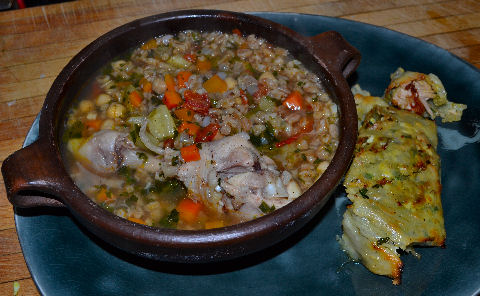
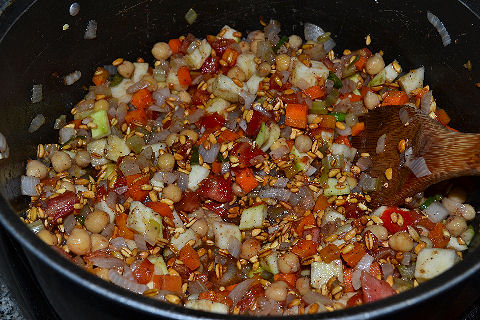
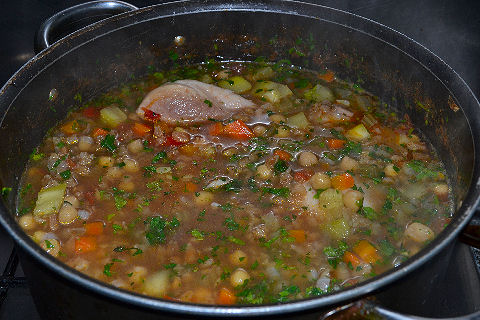
[…] Next time… Algeria. […]